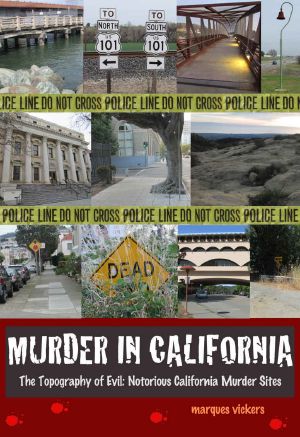Murder in California · the Topography of Evil · Notorious California Murder Sites

- Authors
- Vickers, Marques
- Publisher
- Createspace Independent Publishing Platform
- Tags
- non-fiction , biography , true crime , murder
- ISBN
- 9781517605582
- Date
- 2015-09-30T00:00:00+00:00
- Size
- 7.27 MB
- Lang
- en
The second edition of "Murder in California: The Topography of Evil" is Marques Vickers' visual return to 108 infamous crime scenes detailing the shocking and often searing narratives behind each tragedy. Over 225 images amplify insight by escorting the reader to the crime location, offering a critical context and perspective for understanding. The captured snapshots portray visual testimonies of extinguished lives removed by acts of violence. Crime scenes often revert back into unremarkable landscape or unassuming buildings over the ensuing years and decades. Several have altered little since their moment of infamy. Many are passed daily by pedestrian and vehicular traffic unaware of a location's unique significance. California has been the residence for many notorious profiled individual and serial killers including the Zodiac, Ted Unabomber Kaczynski, Charles Manson, Sirhan Sirhan, Jim Jones, Richard Allen Davis, David Carpenter, The Menendez Brothers, Juan Corona, Rodney Alcala, Phil Spector, Dan White, Juan Corona, Richard Ramirez and Scott Peterson. The media has christened some monikers including the Trailside Killer, Children of Thunder, Co-ed Killer, Vampire of Sacramento, Zebra Killers and the Death House Landlady. The state has been the death site of notable victims including Senator Robert Kennedy, San Francisco Mayor George Moscone, Supervisor Harvey Milk, Mobster Bugsy Siegel, Black Panther Huey P. Newton, Journalist Chauncey Bailey, Nicole Simpson-Brown, Rapper Notorious B.I.G., Polly Klaas, Lacy Peterson, the Heaven's Gate cult, singers Marvin Gaye, Sam Cooke and actors Haing Ngor, Ramon Novarro and Sal Mineo. The Murder in California edition profiles are segmented into nine categories including assassinations, abductions, historical legacies, reckless homicides, chance encounters and manslaughters, law enforcement fatalities and controversies, unsolved murders, rampage and serial killers. Within the context of examining each profile, many important issues and questions are raised without necessarily culminating in resolution. These include capital punishment, racial perceptions, contributing parental influences, media reporting, public opinion, juvenile sentencing, self-incrimination protections and the impartiality of our judicial system. An extensive and updated listing of fatality victims is included along with convicted and deceased killers. Each living convict still registered within the United States penal systems is identified by their current penitentiary residence. Vickers' own introduction to the consequences of murder began with the 1968 killings of David Faraday and Betty Lou Jenson by the Zodiac killer in the author's hometown. Faraday was an acquaintance of Vickers through Boy Scouts and his older sister knew both victims. His reflections on the trauma inflicted on his intimate suburban community correspond with the realization that a single homicide affects far more individuals than simply the victim. Hundreds and often thousands may be touched by the arbitrariness and unfairness of life being terminated abruptly and prematurely.